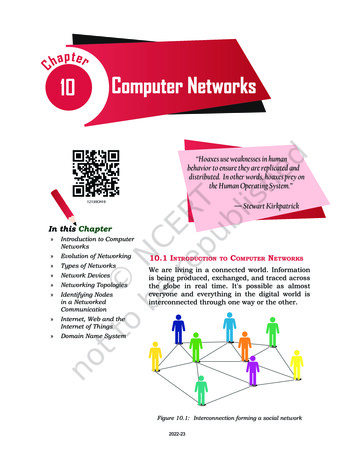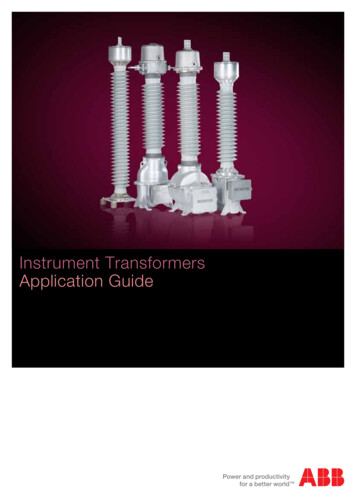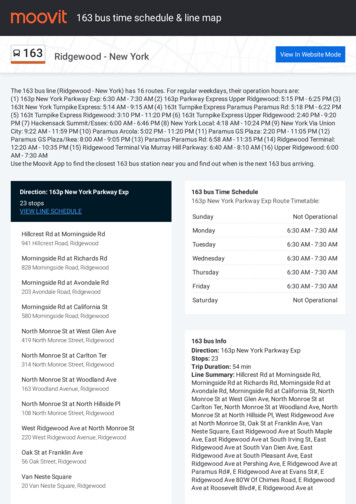
Transcription
apterhC10Computer Networks“Hoaxes use weaknesses in humanbehavior to ensure they are replicated anddistributed. In other words, hoaxes prey onthe Human Operating System.”— Stewart KirkpatrickIn this Chapter»Introduction to ComputerNetworks»Evolution of Networking»Types of Networks»Network Devices»Networking Topologies»Identifying Nodesin a NetworkedCommunication»Internet, Web and theInternet of Things»Domain Name System10.1 INTRODUCTIONTOCOMPUTER NETWORKSWe are living in a connected world. Informationis being produced, exchanged, and traced acrossthe globe in real time. It's possible as almosteveryone and everything in the digital world isinterconnected through one way or the other.Figure 10.1: Interconnection forming a social network2022-23Chpater-10.indd 18111-09-2020 16:41:16
Activity 10.1Identify some othernetworks in thereal world.A group of two or more similar things or peopleinterconnected with each other is called network (Figure10.1). Some of the examples of network in our everydaylife includes: Social network Mobile network Network of computers Airlines, railway, banks, hospitals networksA computer network (Figure 10.2) is an interconnectionamong two or more computers or computing devices.Such interconnection allows computers to share dataand resources among each other. A basic network mayconnect a few computers placed in a room.The network size may vary from small to largedepending on the number of computers it connects.A computer network can include different types ofhosts (also called nodes) like server, desktop, laptop,cellular phones.NetworkingDeviceFigure 10.2: A computer networkApart from computers, networks include networkingdevices like switch, router, modem, etc. Networkingdevices are used to connect multiple computers indifferent settings. For communication, data in a networkis divided into smaller chunks called packets. Thesepackets are then carried over a network. Devices in anetwork can be connected either through wired medialike cables or wireless media like air.In a communication network, each device that is apart of a network and that can receive, create, storeor send data to different network routes is called anode. In the context of data communication, a nodecan be a device such as a modem, hub, bridge, switch,router, digital telephone handset, a printer, a computeror a server.COMPUTER SCIENCE - CLASS XII1822022-23Chpater-10.indd 18211-09-2020 16:41:17
Interconnectivity of computing devices in a networkallows us to exchange information simultaneously withmany parties through email, websites, audio/videocalls, etc. Network allows sharing of resources. Forexample, a printer can be made available to multiplecomputers through a network; a networked storagecan be accessed by multiple computers. People oftenconnect their devices through hotspot, thus forming asmall personal network.10.2 EVOLUTIONOFActivity 10.2Create a hotspot usinga smartphone andconnect otherdevices to it.NETWORKINGIn the 1960s a research project was commissioned byAdvanced Research Projects Agency Network (ARPANET)in the U.S. Department of Defence to connect theacademic and research institutions located at differentplaces for scientific collaborations. The first message wascommunicated between the University of California, LosAngeles (UCLA) and Stanford Research Institute (SRI).Slowly but gradually, more and more organisationsjoined the ARPANET, and many independent smallernetworks were formed. Few of the milestones in themagnificent journey of evolution of computer networksis depicted in the timeline shown in Figure 10.3.The idea of AdvancedResearch Project AgencyNetwork (ARPANET) isconceptualized1961First version of Wi-fi(802.11) standard wasintroducedTCP/IP introduced asstandard protocol onARPANETNational ScienceFoundation bringsconnectivity to morepeople with its NSFNETprogramRoy Tomlinson developsnetwork messaging orE-mail. Symbol @comes to mean "at"1982197119861969ARPANET becamefunctional byconnecting UCLA andSRI199719831974Domain Name SystemintroducedThe term Internet wascoined,First commercial use ofARPANET, was startedin the name of Telenet1990The Berners-Lee atCERN developed HTMLand URL, thus givingbirth to World Wide Web(www)Figure 10.3: Timeline showing evolution of networkingCOMPUTER NETWORKS1832022-23Chpater-10.indd 18311-09-2020 16:41:17
NOTES10.3 TYPESOFNETWORKSThere are various types of computer networks rangingfrom network of handheld devices (like mobile phonesor tablets) connected through Wi-Fi or Bluetooth withina single room to the millions of computers spread acrossthe globe. Some are connected wireless while others areconnected through wires.Based on the geographical area covered and datatransfer rate, computer networks are broadly categorisedas: PAN ( Personal Area Network) LAN (Local Area Network) MAN (Metropolitan Area Network) WAN (Wide Area Network)10.3.1 Personal Area Network (PAN)It is a network formed by connecting a few personaldevices like computers, laptops, mobile phones, smartphones, printers etc., as shown in Figure 10.4. All thesedevices lie within an approximate range of 10 metres.A personal area network may be wired or wireless.For example, a mobile phone connected to the laptopthrough USB forms a wired PAN while two smartphonescommunicating with each other through Bluetoothtechnology form a wireless PAN or WPAN.Figure 10.4:A Personal Area NetworkCOMPUTER SCIENCE - CLASS XII1842022-23Chpater-10.indd 18411-09-2020 16:41:17
10.3.2 Local Area Network (LAN)It is a network that connects computers, mobile phones,tablet, mouse, printer, etc., placed at a limited distance.The geographical area covered by a LAN can range froma single room, a floor, an office having one or morebuildings in the same premise, laboratory, a school,college, or university campus. The connectivity is doneby means of wires, Ethernet cables, fibre optics, or Wi-Fi.A Local Area Network (LAN) is shown in Figure 10.5.Figure 10.5:Explore and find outthe minimum internetspeed required tomake a video call.A Local Area NetworkLAN is comparatively secure as only authenticusers in the network can access other computers orshared resources. Users can print documents usinga connected printer, upload/download documentsand software to and from the local server. Such LANsprovide the short range communication with the highspeed data transfer rates. These types of networks canbe extended up to 1 km. Data transfer in LAN is quitehigh, and usually varies from 10 Mbps (called Ethernet)to 1000 Mbps (called Gigabit Ethernet), where Mbpsstands for Megabits per second. Ethernet is a set of rulesthat decides how computers and other devices connectwith each other through cables in a local area networkor LAN.10.3.3 Metropolitan Area Network (MAN)Metropolitan Area Network (MAN) is an extended form ofLAN which covers a larger geographical area like a city ora town. Data transfer rate in MAN also ranges in Mbps,COMPUTER NETWORKS1852022-23Chpater-10.indd 18511-09-2020 16:41:18
but it is considerably less as compared to LAN. Cable TVnetwork or cable based broadband internet services areexamples of MAN. This kind of network can be extendedup to 30-40 km. Sometimes, many LANs are connectedtogether to form MAN, as shown in Figure 10.6.LAN 1NetworkingDeviceLAN 3LAN 2Figure 10.6: A Metropolitan Area NetworkIt is possible to accessyour bank accountfrom any part of theworld. Whether thebank’s network is aLAN, MAN, WAN orany other type?10.3.4 Wide Area Network (WAN)Wide Area Network connects computers and otherLANs and MANs, which are spread across differentgeographical locations of a country or in differentcountries or continents. A WAN could be formedby connecting a LAN to other LANs (Figure 10.7) viawired/wireless media. Large business, educationaland government organisations connect their differentbranches in different locations across the world throughWAN. The Internet is the largest WAN that connectsbillions of computers, smartphones and millions ofLANs from different continents.COMPUTER SCIENCE - CLASS XII1862022-23Chpater-10.indd 18611-09-2020 16:41:18
Network UserNetwork UserNetwork UserNetwork UserNetwork SwitchNetwork UserNetwork SwitchNetwork UserInternetNetwork UserNetwork UserNetwork UserLAN 1 - DelhiNetwork UserLAN 1 - ShimlaFigure 10.7: A Wide Area Network10.4 NETWORK DEVICESTo communicate data through different transmissionmedia and to configure networks with differentfunctionality, we require different devices like Modem,Hub, Switch, Repeater, Router, Gateway, etc. Let usexplore them in detail.10.4.1 ModemModem stands for ‘MOdulator DEModulator’. It refers toa device used for conversion between analog signals anddigital bits. We know computers store and process datain terms of 0s and 1s. However, to transmit data froma sender to a receiver, or while browsing the internet,digital data are converted to an analog signal and themedium (be it free-space or a physical media) carriesthe signal to the receiver. There are modems connectedto both the source and destination nodes. The modemat the sender’s end acts as a modulator that convertsthe digital data into analog signals. The modem at thereceiver’s end acts as a demodulator that convertsthe analog signals into digital data for the destinationnode to understand. Figure 10.8 shows connectivityusing a modem.COMPUTER NETWORKS1872022-23Chpater-10.indd 18711-09-2020 16:41:19
Analog SignalModulationDigital SignalDemodulationDemodulationModulationDigital SignalTelephone LineModemModemFigure 10.8: Use of modemFigure 10.9:10.4.2 Ethernet CardEthernet card, also known as Network Interface Card(NIC card in short) is a network adapter used to setup a wired network.It acts as an interfacebetween computer andthe network. It is a circuitboard mounted on themotherboard of a computerasshowninFigure10.9. The Ethernet cableconnects the computer tothe network through NIC.Ethernet cards can supportdata transfer between 10Mbps and 1 Gbps (1000Mbps). Each NIC has aMAC address, which helpsin uniquely identifying thecomputer on the network.A Network Interface Card10.4.3 RJ45RJ 45 or Registered Jack-45 is aneight-pin connector (Figure 10.10)that is used exclusively withEthernet cables for networking.It is a standard networkinginterface that can be seen atthe end of all network cables.Basically, it is a small plastic plugthat fits into RJ-45 jacks of theEthernet cards present in variouscomputing devices.Figure 10.10: RJ 45COMPUTER SCIENCE - CLASS XII1882022-23Chpater-10.indd 18811-09-2020 16:41:19
10.4.4 RepeaterData are carried in the form of signals over the cable.These signals can travel a specified distance (usuallyabout 100 m). Signals lose their strength beyond thislimit and become weak. In such conditions, originalsignals need to be regenerated.A repeater is an analog device that works with signalson the cables to which it is connected. The weakenedsignal appearing on the cable is regenerated and putback on the cable by a repeater.An Internet serviceprovider (ISP) is anyorganisation thatprovides servicesfor accessing theInternet.10.4.5 HubAn Ethernet hub (Figure 10.11) is a network device usedto connect different devices through wires. Data arrivingon any of the lines are sent out on all the others. Thelimitation of Hub is that if data from two devices comeat the same time, they will collide.Activity 10.312345678Find and list afew ISPs in yourregion.Figure 10.11: A network hub with 8 ports10.4.5 SwitchA switch is a networking device (Figure 10.12) thatplays a central role in a Local Area Network (LAN). Likea hub, a network switch is used to connect multiplecomputers or communicating devices. When dataarrives, the switch extracts thedestination address from the datapacket and looks it up in a table tosee where to send the packet. Thus,it sends signals to only selecteddevices instead of sending to all.It can forward multiple packets atthe same time. A switch does notforward the signals which are noisyor corrupted. It drops such signalsFigure 10.12: Cables connected to a network switchand asks the sender to resend it.Ethernet switches are common in homes/officesto connect multiple devices thus creating LANs or toaccess the Internet.COMPUTER NETWORKS1892022-23Chpater-10.indd 18911-09-2020 16:41:20
NOTES10.4.6 RouterA router (Figure 10.13) is a network device that canreceive the data, analyse it and transmit it to othernetworks. A router connects a local area network to theinternet. Compared to a hub or a switch, a router hasadvanced capabilities as it can analyse the data beingcarried over a network, decide/alter how it is packaged,and send it to another network of a different type. Forexample, data has been divided into packets of a certainsize. Suppose these packets are to be carried over adifferent type of network which cannot handle biggerpackets. In such a case, the data is to be repackagedas smaller packets and then sent over the network bya router.Figure 10.13: A routerA router can be wired or wireless. A wireless routercan provide Wi-Fi access to smartphones and otherdevices. Usually, such routers also contain some portsto provide wired Internet access. These days, home Wi-Firouters perform the dual task of a router and a modem/switch. These routers connect to incoming broadbandlines, from ISP (Internet Service Provider), and convertthem to digital data for computing devices to process.10.4.7 GatewayAs the term “Gateway” suggests, it is a key access pointthat acts as a “gate” between an organisation's networkand the outside world of the Internet (Figure 10.14).Gateway serves as the entry and exit point of a network,as all data coming in or going out of a network mustfirst pass through the gateway in order to use routingpaths. Besides routing data packets, gateways alsomaintain information about the host network's internalconnection paths and the identified paths of otherremote networks. If a node from one network wants tocommunicate with a node of a foreign network, it willCOMPUTER SCIENCE - CLASS XII1902022-23Chpater-10.indd 19011-09-2020 16:41:20
pass the data packet to the gateway, which then routesit to the destination using the best possible route.10.0.0.0/8IP ADDRESSServerPC 4PC 5PC 1ServerGATEWAYPC 220.0.0.0/8IP ADDRESSPC 4PC 3PC 1PC 5PC 2PC 3Figure 10.14: A network gatewayFor simple Internet connectivity at homes, thegateway is usually the Internet Service Provider thatprovides access to the entire Internet. Generally, arouter is configured to work as a gateway devicein computer networks. But a gateway can beimplemented completely in software, hardware, ora combination of both. Because a network gatewayis placed at the edge of a network, the firewall isusually integrated with it.10.5 NETWORKING TOPOLOGIESWe have already discussed that a number of computingdevices are connected together to form a Local AreaNetwork (LAN), and interconnections among millions ofLANs forms the Internet. The arrangement of computersand other peripherals in a network is called its topology.Common network topologies are Mesh, Ring, Bus, Starand Tree.COMPUTER NETWORKS1912022-23Chpater-10.indd 19111-09-2020 16:41:21
10.5.1 Mesh TopologyIn this networking topology, each communicatingdevice is connected with every other device in thenetwork as shown in Figure 10.15. Such a network canhandle large amounts of traffic since multiple nodescan transmit data simultaneously. Also, such networksare more reliable in the sense that even if a node getsdown, it does not cause any break in the transmissionof data between other nodes. This topology is alsomore secure as compared to other topologies becauseeach cable between two nodes carries different data.However, wiring is complex and cabling cost is high increating such networks and there are many redundantor unutilised connections.Figure 10.15: A mesh topologyTo build a fullyconnected meshtopology of n nodes,it requires n(n-1)/2wires.10.5.2 Ring TopologyIn ring topology (Figure 10.16), each node is connectedto two other devices, one each on either side, as shownin Figure 10.16. The nodes connected with eachother thus forms a ring. The link in a ring topology isunidirectional. Thus, data can be transmitted in onedirection only (clockwise or counterclockwise).Figure 10.16: A ring topology10.5.3 Bus TopologyIn bus topology (Figure 10.17), each communicatingdevice connects to a transmission medium, known asbus. Data sent from a node are passed on to the busand hence are transmitted to the length of the bus inboth directions. That means, data can be received byany of the nodes connected to the bus.COMPUTER SCIENCE - CLASS XII1922022-23Chpater-10.indd 19211-09-2020 16:41:21
BusFigure 10.17: A bus topologyIn this topology, a single backbone wire called bus isshared among the nodes, which makes it cheaper andeasier to maintain. Both ring and bus topologies areconsidered to be less secure and less reliable.10.5.4 Star TopologyIn star topology (Figure 10.18), each communicatingdevice is connected to a central node, which is anetworking device like a hub or a switch, as shown inFigure 10.18.How will a Bus andRing topology behavein case a Node isdown?Star topology is considered very effective, efficientand fast as each device is directly connected with thecentral device. Although disturbance in one device willnot affect the rest of the network, any failure in a centralnetworking device may lead to the failure of completenetwork.Figure 10.18: A star topologyThe central node can be either a broadcasting devicemeans data will be transmitted to all the nodes in thenetwork, or a unicast device means the node can identifythe destination and forward data to that node only.10.5.5 Tree or Hybrid TopologyIt is a hierarchical topology, in which there are multiplebranches and each branch can have one or more basictopologies like star, ring and bus. Such topologies areusually realised in WANs where multiple LANs areconnected. Those LANs may be in the form of a ring,bus or star. In figure 10.19, a hybrid topology is shownconnecting 4-star topologies in a bus.In this type of network, data transmitted from sourcefirst reaches the centralised device and from there thedata passes through every branch where each branchcan have links for more nodes.COMPUTER NETWORKS1932022-23Chpater-10.indd 19311-09-2020 16:41:21
Figure 10.19: A hybrid topology10.6 IDENTIFYING NODESCOMMUNICATIONIN ANETWORKEDEach node in a network should be uniquely identifiedso that a network device can identify the sender andreceiver and decide a routing path to transmit data.Let us explore further and know how each node isdistinguished in a network.10.6.1 MAC AddressMAC stands for Media Access Control. The MAC address,also known as the physical or hardware address, is aunique value associated with a network adapter calleda NIC. The MAC address is engraved on NIC at the timeof manufacturing and thus it is a permanent addressand cannot be changed under any circumstances. Themachine on which the NIC is attached, can be physicallyidentified on the network using its MAC address.Each MAC address is a 12-digit hexadecimal numbers(48 bits in length), of which the first six digits (24 bits)contain the manufacturer’s ID called OrganisationalUnique Identifier (OUI) and the later six digits (24 bits)represents the serial number assigned to the card bythe manufacturer. A sample MAC address looks like:Activity 10.4Explore how can youfind the MACaddress of yourcomputersystem.10.6.2 IP AddressIP address, also known as Internet Protocol address,is also a unique address that can be used to uniquelyidentify each node in a network. The IP addressesCOMPUTER SCIENCE - CLASS XII1942022-23Chpater-10.indd 19411-09-2020 16:41:21
are assigned to each node in a network that uses theInternet Protocol for communication. Thus, if we knowa computer’s IP address, we can communicate withthat computer from anywhere in the world. However,unlike MAC address, IP address can change if a nodeis removed from one network and connected to anothernetwork.The initial IP Address called version 4 (IPV4 in short),is a 32 bit numeric address, written as four numbersseparated by periods, where each number is the decimal(base-10) representation for an 8-bit binary (base-2)number and each can take any value from 0 - 255. Asample IPV4 address looks like:Do mobile phoneshave a MAC address?Is it different fromthe IMEI number ofmobile phones?192:168:0:178With more and more devices getting connected tothe Internet, it was realised that the 32-bit IP addresswill not be sufficient as it offers just under 4.3 billionunique addresses. Thus, a 128 bits IP address, called IPversion 6 (IPV6 in short) was proposed. An IPv6 addressis represented by eight groups of hexadecimal (base-16)numbers separated by colons. A sample IPV6 addresslooks like:2001:CDBA:0000:0000:0000:0000:3257:965210.7 INTERNET, WEBAND THEINTERNETOFTHINGSThe Internet is the global network of computing devicesincluding desktop, laptop, servers, tablets, mobilephones, other handheld devices, printers, scanners,routers, switches, gateways, etc. Moreover, smartelectronic appliances like TV, AC, refrigerator, fan, light,etc. can also communicate through a network. The listof such smart devices is always increasing e.g., drones,vehicles, door lock, security camera. We have alreadystudied IoT and WoT in class 11.The Internet is evolving every day and it is difficultto visualise or describe each and every aspect of thearchitecture of the Internet. Computers are eitherconnected to a modem through a cable or wirelessly (WiFi). That modem, be it wired or wireless, is connected toa local Internet Service Provider (ISP) who then connectsto a national network. Many such ISPs connect togetherforming a regional network and regional networksconnect together forming a national network, and suchcountry-wise networks form the Internet backbone.COMPUTER NETWORKS1952022-23Chpater-10.indd 19511-09-2020 16:41:21
You are encouragedto take up any areaof concern whereyou think IoT can beimmensely beneficialand discuss it withyour peers. Anexample for the samecan be preventingroad accidents.The Internet today is a widespread network, and itsinfluence is no longer limited to the technical fields ofcomputer communications. It is being used by everyonein the society as is evident from the increasing use ofonline tools for education, creativity, entertainment,socialisation, and e-commerce.10.7.1 The World Wide Web (WWW)The World Wide Web (WWW) or web in short, is anocean of information, stored in the form of trillionsof interlinked web pages and web resources. Theresources on the web can be shared or accessedthrough the Internet.Earlier, to access files residing in differentcomputers, one had to login individually to eachcomputer through the Internet. Besides, files indifferent computers were sometimes in differentformats, and it was difficult to understand each other’sfiles and documents. Sir Tim Berners-Lee — a Britishcomputer scientist invented the revolutionary WorldWide Web in 1990 by defining three fundamentaltechnologies that lead to creation of web: HTML – HyperText Markup Language. It is a languagewhich is used to design standardised Web Pages sothat the Web contents can be read and understoodfrom any computer. Basic structure of every webpageis designed using HTML.URI – Uniform Resource Identifier. It is a uniqueaddress or path for each resource located on theweb. It is also known as Uniform Resource Locator(URL). Every page on the web has a unique URL.Examples are: tp://www.airindia.in, etc. URLis sometimes also called web address. However,a URL is not only the domain name. It containsother information that completes a web address,as depicted below:Domain RL HTTP – The HyperText Transfer Protocol is a set ofrules which is used to retrieve linked web pagesacross the web. The more secure and advancedversion is HTTPS.COMPUTER SCIENCE - CLASS XII1962022-23Chpater-10.indd 19611-09-2020 16:41:21
Many people confuse the web with the Internet.The Internet as we know is the huge global networkof interconnected computers, which may or may nothave any file or webpage to share with the world. Theweb on the other hand is the interlinking of collectionof Webpages on these computers which are accessibleover the Internet. WWW today gives users access to avast collection of information created and shared bypeople across the world. It is today the most popularinformation retrieval systemNOTES10.8 DOMAIN NAME SYSTEMThe Internet is a vast ocean where information isavailable in the form of millions of websites. Each websiteis stored on a server which is connected to the Internet,which means each server has an IP address. Everydevice connected to the Internet has an IP address. Toaccess a website, we need to enter its IP address on ourweb browser. But it is very difficult to remember the IPaddresses of different websites as they are in terms ofnumbers or strings.However, it is easier to remember names, andtherefore, each computer server hosting a website orweb resource is given a name against its IP address.These names are called the Domain names or hostnamescorresponding to unique IP addresses assigned to eachserver. For easy understanding, it can be consideredas the phonebook where instead of remembering eachperson’s phone number, we assign names to theirnumbers. For example, IP addresses and domain namesof some websites are as follows:Table 10.1 Examples of domain names and theirmapped IP addressesDomain NameIP 35.26.9610.8.1 DNS ServerInstead of remembering IP addresses, we assign adomain name to each IP. But, to access a web resource,a browser needs to find out the IP address correspondingto the domain name entered. Conversion of the domainCOMPUTER NETWORKS1972022-23Chpater-10.indd 19711-09-2020 16:41:21
name of each web server to its corresponding IP addressis called domain name resolution. It is done througha server called DNS server. Thus, when we enter aURL on a web browser, the HTTP protocol approachesa computer server called DNS server to obtain the IPaddress corresponding to that domain name. Aftergetting the IP address, the HTTP protocol retrieves theinformation and loads it in our browser.In Figure 10.20, an example is shown in which theHTTP requests a DNS server for corresponding IP addss,and the server sends back an IP address.DNS root serversare named usingalphabets A throughM for the first13 letters of thealphabet. Ten ofthese servers arein the US, one inLondon, one inStockholm, andone in Japan.The organisationInternet AssignedNumbers Authority(IANA) keeps thislist of DNS rootservers.User164.100.60.233HTTP inBrowserwww.ncert.nic.inDNSServerFigure 10.20: Request of IP address corresponding to domain nameA DNS server maintains a database of domain namesand their corresponding IP addresses. To understandhow the domain name resolution works, we have tounderstand how and where the DNS servers are kept.The DNS servers are placed in hierarchical order. Atthe top level, there are 13 servers called root servers.Then below the root servers there are other DNS serversat different levels. A DNS server may contain the IPaddress corresponding to a domain or it will containthe IP address of other DNS servers, where this domainentry can be searched.SUMMARY A computer network is an interconnection amongtwo or more computers or computing devices.A computer network allows computers to sharedata and resources among each other.Networking devices are used to connect multiplecomputers in different settings.COMPUTER SCIENCE - CLASS XII1982022-23Chpater-10.indd 19811-09-2020 16:41:21
In a communication network, each device that isa part of a network and that can receive, create,store or send data to different network routes iscalled a node.Based on the geographical area covered and datatransfer rate, computer networks are broadlycategorised into LAN (Local Area Network), MAN(Metropolitan Area Network) and WAN (Wide AreaNetwork).LAN is a network that connects a variety of nodesplaced at a limited distance ranging from a singleroom, a floor, an office or a campus having one ormore buildings in the same premises.Ethernet is a set of rules that decides howcomputers and other devices connect with eachother through cables in a LAN.Metropolitan Area Network (MAN) is an extendedform of LAN which covers a larger geographicalarea like a city or a town.Cable TV network or cable based broadbandinternet services are examples of MAN.Wide Area Network (WAN) connects computersand other LANs and MANs, which are spreadacross different geographical locations of acountry or in different countries or continents.The Internet is the largest WAN that connectsbillions of computers, smartphones and millionsof LANs from different continents.Modem stands for ‘MOdulator DEModulator’,is a device used for conversion between electricsignals and digital bits.Ethernet card, also known as Network InterfaceCard (NIC card in short) is a network adaptorused to set up a wired network.Each NIC has a MAC address, which helps inuniquely identifying the computer on the network.A repeater is an analog device that regenerate thesignals on the cables to which it is connected.A switch is a networking device used to connectmultiple computers or communicating devices.A router is a network device that can receive thedata, analyse it and transmit it to other networks.COMPUTER NETWORKSNOTES1992022-23Chpater-10.indd 19911-09-2020 16:41:21
NOTES Gateway serves as the entry and exit point of anetwork, as all data coming in or going out of anetwork must first pass through the gateway inorder to use routing paths.The arrangement of computers and otherperipherals in a network is called its topology.Common network topologies are
Network of computers Airlines, railway, banks, hospitals networks A computer network (Figure 10.2) is an interconnection among two or more computers or computing devices. Such interconnection allows computers to share data and resources among each other. A basic network may connect a few computers placed in a room.











